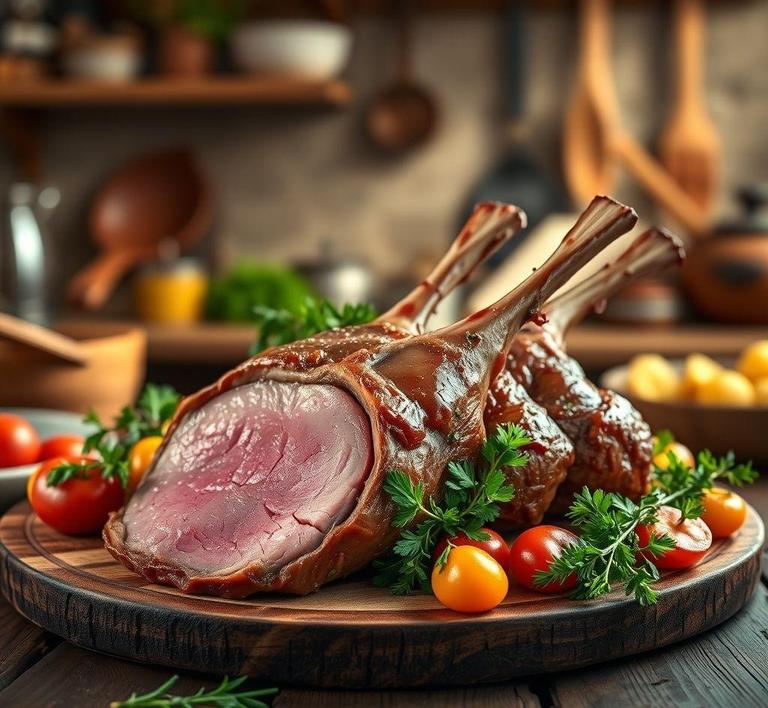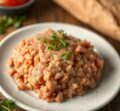If you’ve ever wondered whether it’s safe to refreeze fresh lamb, you’re not alone. Refreezing meat is a bit of a gray area for many people, but with the right approach, it’s totally possible to do safely. The key to refreezing lamb lies in proper handling and understanding the science behind freezing and thawing. This guide will walk you through everything you need to know about refreezing fresh lamb, from how to preserve its flavor and texture to the best practices for doing so without compromising safety. So, whether you’re looking to save leftovers or manage your meal prep, let’s break down the process step by step!
Can You Refreeze Fresh Lamb?

The short answer is yes-you can refreeze fresh lamb, but with caveats that demand careful attention. Lamb, a rich and delicate red meat, is highly perishable and sensitive to temperature fluctuations. Whether you’re handling a tender lamb shank or a marbled shoulder cut, understanding how and when you can safely refreeze it is essential for both food safety and preserving quality.
The USDA generally allows the refreezing of raw meat, including lamb, provided it was thawed properly-specifically, in the refrigerator and not at room temperature or using warm water. This distinction is crucial. When thawed under refrigeration (at or below 40°F/4°C), lamb remains at a safe temperature that inhibits bacterial growth, allowing it to be safely returned to the freezer. However, if lamb has been left out on a countertop or exposed to warmer temperatures for an extended period, refreezing it could pose a risk of foodborne illness due to potential microbial contamination.
In summary: Yes, you can refreeze fresh lamb, but only if it was thawed safely and shows no signs of spoilage such as sour odor, discoloration, or a slimy texture.
How To Refreeze Fresh Lamb?
If you’ve determined your lamb is still safe to eat, refreezing it properly is your next step. Here’s a step-by-step guide to ensure maximum safety and quality:
-
🧊 Assess the Condition
First, check the lamb thoroughly. Look for any off-putting smells, changes in texture, or discoloration. If the meat feels sticky, slimy, or has a grayish hue, it should be discarded, not refrozen.
-
🧼 Handle with Hygiene
Always wash your hands before and after handling raw lamb. Use clean utensils and cutting boards to avoid cross-contamination with other foods, especially ready-to-eat items.
-
🧺 Portion for Convenience
Divide the lamb into portion sizes you’ll realistically use in a single cooking session. This minimizes future thawing and refreezing cycles, which further degrade the meat’s quality.
-
🥶 Wrap It Right
Use freezer-safe, airtight packaging such as vacuum-sealed bags, heavy-duty aluminum foil, or double layers of plastic wrap followed by a freezer bag. Removing as much air as possible helps prevent freezer burn.
-
🏷️ Label and Date
Always label your refrozen lamb with the current date and the original freeze date, if available. This helps you track how long the meat has been frozen and use it before quality deteriorates significantly.
-
❄️ Freeze Promptly
Place the wrapped lamb into the coldest part of the freezer, ideally set at 0°F (-18°C) or below. Freezing quickly slows down any potential enzymatic or microbial activity.
Quality Impact
While refreezing fresh lamb is generally safe when done correctly, it’s important to acknowledge the impact this process has on the meat’s quality.
-
🧪 Texture Degradation
The biggest downside of refreezing is the potential for texture loss. Each freeze-thaw cycle causes water in the meat to crystallize, then melt, disrupting the muscle fibers. This can result in lamb that feels mushier or drier once cooked.
-
🧂 Flavor Diminishment
Alongside texture, flavor may suffer. Lamb’s distinct, rich taste can flatten or take on stale freezer notes over time, especially if the packaging is not airtight. Proper wrapping mitigates this, but subtle losses are often inevitable.
-
❌ Freezer Burn Risk
Improperly wrapped meat can fall victim to freezer burn-a condition where surface moisture evaporates, leaving behind tough, leathery, grayish patches. While not dangerous, these areas taste unpleasant and can ruin your dish’s overall appeal.
-
⏳ Reduced Shelf Life
Refrozen lamb should ideally be used within 1 to 2 months. Although safe to eat beyond this, its peak flavor and tenderness diminish the longer it sits in the freezer after a second freeze.
Refreezing fresh lamb is both possible and safe-when handled with precision. The key lies in ensuring the lamb was originally thawed under refrigerated conditions, maintaining impeccable hygiene, and refreezing it quickly and securely. However, while safety can be managed, quality cannot be fully preserved. Expect some degradation in texture and flavor with each freeze-thaw cycle, particularly if the lamb wasn’t flash-frozen or vacuum-sealed.
For the home cook, the best practice is prevention: freeze in smaller portions from the outset, thaw only what you need, and minimize the number of times meat transitions between frozen and thawed states. When managed with care, you can still enjoy lamb’s complex, gamey richness-even after a return trip to the freezer.
Is It Safe To Refreeze Fresh Lamb?
Refreezing fresh lamb is a common practice in many households, especially when bulk purchases are involved. But is it safe? The short answer is: yes, under the right conditions. Refreezing lamb can be safe and practical if you follow proper food safety guidelines. However, this process is not without its caveats.
The key factor that determines whether lamb can be safely refrozen is how it has been handled since it was last thawed. If the lamb was thawed in the refrigerator and kept below 40°F (4°C), it can be safely refrozen. This method ensures that the meat remains at a safe temperature where harmful bacteria, such as Salmonella or E. coli, cannot multiply rapidly.
On the other hand, if lamb has been thawed at room temperature, in a warm water bath, or in the microwave, refreezing it is strongly discouraged. These methods introduce temperature danger zones (between 40°F and 140°F), where bacterial growth can skyrocket within hours. Even if the lamb looks and smells fine, refreezing it after such exposure could pose serious health risks.
It’s also important to remember that while refreezing lamb may be safe, it does affect the texture and quality of the meat. Each freeze-thaw cycle breaks down muscle fibers and causes moisture loss. This can result in lamb that’s drier, less tender, and less flavorful when cooked.
Signs That Fresh Lamb Should Not Be Refrozen
Before deciding to refreeze lamb, it’s essential to inspect it thoroughly. The following signs are strong indicators that lamb is no longer safe for consumption-let alone refreezing:
- Unpleasant Odor: Fresh lamb should have a mild, slightly metallic scent. If it gives off a sour, ammonia-like, or otherwise foul odor, spoilage is likely.
- Slimy Texture: A tacky or sticky film on the surface of the meat suggests bacterial activity and spoilage. Fresh lamb should be firm to the touch and not excessively wet.
- Discoloration: Lamb that has turned greenish, grey, or exhibits iridescent sheens should not be refrozen or consumed. Natural color variations are normal, but drastic changes indicate decay.
- Excessive Thaw Time at Room Temperature: If the lamb has been left out for more than two hours (or one hour in temperatures above 90°F/32°C), it should be discarded. Bacteria multiply quickly in these conditions.
- Ice Crystals or Freezer Burn: If you previously froze the lamb improperly and it shows signs of freezer burn-dry patches or white, leathery spots-it’s not unsafe per se, but the quality has deteriorated enough that refreezing is not advisable.
Common Refreezing Mistakes
Refreezing lamb may seem straightforward, but several missteps can compromise safety and flavor. Avoid these common errors to ensure the best outcomes:
- Thawing at Room Temperature: Leaving lamb on the counter for hours is one of the most hazardous practices. Always thaw in the refrigerator to maintain a safe temperature.
- Refreezing After Partial Cooking: Partially cooked lamb can harbor bacteria that survive initial heat exposure. Unless fully cooked, it should not be refrozen.
- Ignoring Time Limits: Refreezing lamb that has been in the fridge for more than 3-5 days after thawing is risky. Bacterial growth occurs even under refrigeration, albeit slowly.
- Using Damaged Packaging: If lamb has been exposed to air or stored in punctured packaging, it can suffer freezer burn or contamination. Always use airtight, freezer-safe containers or heavy-duty freezer bags.
- Refreezing Repeatedly: Every freeze-thaw cycle impacts lamb’s quality. Ideally, only refreeze once. Repeated freezing leads to flavor loss, toughness, and greater moisture depletion.
Tips And Tricks
To safely and successfully refreeze lamb while maintaining as much quality as possible, consider these practical tips and tricks:
- Label and Date Everything: Always label lamb with the original freezing date and the date it was thawed. This makes it easier to track freshness and avoid refreezing expired meat.
- Portion Before Freezing: Divide lamb into meal-sized portions before freezing. This eliminates the need to thaw and refreeze large batches repeatedly.
- Use Vacuum Sealing: Vacuum-sealing removes air and helps preserve the texture and taste of lamb while reducing freezer burn risk.
- Flash Freeze if Possible: Lay lamb pieces on a tray and pre-freeze them individually before placing them in storage bags. This prevents clumping and makes it easier to retrieve only what you need later.
- Cool Before Freezing: If cooking lamb before freezing, let it cool completely at room temperature for no more than 1 hour, then chill it in the refrigerator before freezing. This prevents condensation and ice crystal formation.
- Keep a Cold Freezer: Your freezer should always be at or below 0°F (-18°C). A thermometer can help you verify this.
Conclusion
Refreezing fresh lamb is entirely possible and safe when done correctly. The decision to refreeze should always be guided by how the meat was thawed, how long it’s been out, and whether there are any visible or olfactory signs of spoilage. Avoid common pitfalls like repeated freezing, improper thawing, and poor storage techniques.
By understanding the science and safety behind refreezing lamb-and implementing some smart storage habits-you can confidently manage your meat supply without sacrificing flavor, texture, or, most importantly, food safety. Whether you’re a home cook or a culinary enthusiast, these best practices will ensure your lamb remains a delicious and safe part of your meals.


